Keywords
|
| Occupational hazards, dental practitioners, Yoga as an alternative therapy, Statistical study. |
INTRODUCTION
|
| Dental professionals are predisposed to a number of occupational hazards.Occupational hazard can be defined as the risk to the health of a person usually arising out of employment. It can also refer to work, material, substance, process or situation that predisposes or itself causes accidents or disease at work place. The history of occupational hazard awareness can be traced back to the 18th century when BernadinoRamazzini, who is referred to as the ‘Father of Occupational Medicine’, recognized the role of occupation in the dynamics of health and diseases [1]. Occupational health hazards are not uncommon [2], [3]. Many risks challenge the status of modern dentistry. Studies have shown that dentists report more frequent and worse health problems than other high risk medical professionals [5]. Dental personnel are exposed to various occupational hazards like stress, physical strain, musculoskeletal disorders, legal hazards etc.Though dentists face many hazards in their occupation, the common hazards faced by them are physical strain such as musculo skeletal problem, chronic back pain and mental stress. |
| Estimates suggest that 84% of people may experience low back pain (LBP) at some point in their lifetime[7]. A primary reason individuals seek medical care is for LBP, which can be costly to treat and manage[8]. Risk factors for long-term LBP include age, depression, previous history of back pain, pain distal to the knee, and dissatisfaction with job [9]. Many common treatments for LBP have been found to be ineffective[7], thus, individuals suffering from LBP are turning to some alternative treatment methods, such as yoga [7], [10-14].Low back pain typically affects individuals between 30 and 50 years of age with the prevalence increasing through adulthood up to 65 years of age [8]. Men and women are affected equally by LBP, and the cause can usually be traced to a work-related disability in adults younger than 45 years[7]. |
| Another important hazard that dentists face in their occupation is mental stress.Stress is the abnormal reaction that the organism displays against threating environmental elements (Luthans, 1994). Stress, which is a general term used for pressure that people are exposed to in life (Jepson and Forrest, 2006) may be defined as the individual harmony effort that the person displays against a stimulant which has excessive psychological and physical pressure on the person. (Griffin, 1990). When a person feels insufficient in dealing with demands and challenges faced in life, she/he experiences stress [6]. Being harmed by thissitution or taking advantage of it mainly depends on the person because stress may either be a factor threatening the organism physically or psychologically or a power which gives energy in dealing with life (Balta?, 2002). Sources of stress may be classified as individual, organizational and outside of organization (Gupta, 1981; Kreitner and Kinick, 1992) or it is possible to divide them into two groups as individual and organizational components (Nahavandi and Malekzadeh, 1999; Smith and Milstein, 1984). Organizational stress, which is also called professional stress, is the interaction between working conditions and the working person in environments in which the work demand exceeds the skills of the worker (Ross and Altmaier, 1994). |
| There is considerable evidence that the stress inherent in health care negatively impacts health care professionals. Stress can lead to increaseddepression (Tyssen, Vaglum, Gronvold, &Ekeberg, 2001), decreased job satisfaction (Blegen, 1993; Flanagan & Flanagan, 2002), disrupted personal relationships (Gallegos, Bettinardi-Angres, &Talbott, 1990), psychological distress (V. Jain, Lall, McLaughlin, & Johnson, 1996); and even suicide (Richings, Khara, & McDowell, 1986). Stress also may harm professional effectiveness: It decreases attention (Smith, 1990), reduces concentration(Askenasy&Lewin, 1996), impinges on decision-making skills (Klein, 1996; Lehner, Seyed- Solorforough, O’Connor, Sak, & Mullin, 1997), and reduces providers’ abilities to establish strong relationships with patients (Pastore, Gambert, Plutchik, &Plutchik, 1995) [6]. |
| Stress also may lead to increased burnout (Spickard, Gabbe, & Christensen, 2002), defined as a syndrome of depersonalization, emotional exhaustion, and a sense of low personal accomplishment. A recent study found that burnout was significantly associated with suboptimal self-reported patient care (Shanafelt, Bradley, Wipf, & Back, 2002). Over a decade ago, the field identified these problems and called for change, advocating better care for health professionals (Butterfield, 1988). Despite this call for change, dissatisfaction and distress have continued to increase. For example, a study of U.S. physicians showed a decline in satisfaction with every aspect of their professional life from 1986 to 1997 (Murray et al., 2001). It is clear that health care professionals need support in addressing the numerous stressors inherent in their work. |
| Now days, to get relieved from occupational hazards, people are turning towards complementary therapies rather than medical treatments. One among them is yoga, which helps the dentists to get rid of themselves from various hazards they face in their occupation. Yoga, which uses a more holistic approach when compared with conventional methods [17] [18], has been shown to decrease symptoms with chronic low back pain (cLBP) and stress [10]. It is believed that recurrences of debilitating LBP are particularly high in individuals with cLBP [16]. The estimated range for recurrence at 1 year is 24% to 80% [15]. |
STATISTICAL STUDY
|
| To analyse the prevalence of yoga as an alternative therapy for occupational hazards, the study was carried out in the year 2013. The population of the study composed of dentists from various hospitals present at Chennai, India. The study has been carried out by simple questionnaire method in which the following simple questions with options have been asked to the dentists. |
| 1) What is your age? |
| 1) <30 2) 30 – 40 3) >40 |
| 2) What is your sex? |
| 1) male 2) female |
| 3) What is your experience? |
| 1) <10 2) 10 – 20 3) >20 |
| 4) How many hours you work per day? |
| 1) <4 hrs 2) >4 hrs |
| 5) Do you have any systemic disease? |
| 1) diabetes 2) hypertension 3) both 4) none |
| 6) What occupational hazard you face as a dentist? |
| 1) musculoskeletal pain 2) stress 3) both |
| 7) How often do you get it? |
| 1) often – weekly once 2) rare – monthly once 3) never |
| 8) How do you prevent these? |
| 1) exercise, massage, music, walking 2)yoga 3) none |
| 9) Do you have any harmful habit (Smoking/Alcohol)? |
| 1) yes 2) no |
| 10) Why are you not practising yoga? |
| 1) no access to learn 2) no time to do 3) don’t believe in yoga |
| A. Data Collection and Analysis |
| Data of some 394 samples have been collected based on the above questionnaire method. The collected data has been analysed using a statistical analysis tool called Minitab (version 17) and the categories of the dentists based on age, sex, experience, etc. have been tabulated and shown below. |
| 68% of the participants belongs to the age group of below 30, 29% comes under the age group of 30 – 40 and 3% belongs to the age group of above 40. 64% of the dentists who participated in this statistical study are male and remaining 36% are female. About 66% of the dentists have less than 10 years of experience, 30% have 10 – 20 years of experience and remaining 4% have more than 20 years of experience. Fig. 1 – 3 represents this analysis graphically. |
| In fig. 3 the values in the X-axis represents the corresponding options present in the questionnaire. |
| On analysing the factors that plays a role in causing the mentioned occupational hazards, the following table has been derived. |
| 32% of the participants work less than 4 hrs per day and 68% of them work more than 4 hrs per day. 95% of the dentists do not suffer from any of the mentioned systemic disease, 1% suffer from diabetes and 2% suffer from hypertension, remaining 2% suffer from both the diseases. 26% of the dentists undergo musculoskeletal pain, 28% undergo stress and 46% undergo both. This analysis has been represented graphically in Fig. 4 – 6. The values in the Xaxis represents the corresponding options present in the questionnaire. |
| From the data set collected, on observing the questionnaire related to the prevalence of yoga as an alternative remedy for the occupational hazards, the following statistics have been tabulated. |
| 25% of the dentists in the statistical analysis face the occupational hazard often, 28% face the hazards rarely and 47% never face any of the occupational hazards. As a method of prevention 10% of them do exercise, listen to music, go for walking, etc., and 47% do yoga. 43% of them do not take any of the prevention methods. 28% of the participants have harmful habits such as smoking and alcohol and 72% of them do not have any of the harmful habits. 13% of the dentists do practice yoga to prevent occupational hazard because they don’t have access to learn, 23% of them did not do yoga since they don’t have time and 64% of them did not do because they don’t have belief in yoga. Fig. 7 – 8 shows this analysis graphically. |
RESULTS AND DISCUSSION
|
| From the above statistical analysis of the collected data, the following information is inferred: |
| Analysis of questionnaire 7 says that, 38% (149 in count) of the dentists often face the occupational hazard, 34% (131 in count) of them face the hazard rare, 28% (114 in count) never face this problem. |
| Out of 114 dentists who does not face any occupational hazards, it has been inferred that, 25 (22%) dentists prevent this hazard by doing exercise, massage, walking, etc., 33 (30%) of them prevent the hazard by practicing yoga and 56 (48%) does not undergo any prevention methods. |
| From this it is clear that yoga can be used as a better alternative remedy for occupational hazards than exercise, massage, etc. but still, many are not practising it. |
| Analysis of questionnaire 10 says that 13% of the participants do not do yoga since they have no access to learn, 24% do not do it as they have no time and 63% do not do yoga since they have no belief in it.The histograms given in fig. 12 and fig. 13 shows this graphically. |
| Thus, from the above discussion it is clear that if yoga is used as an alternative remedy for occupational hazards like musculoskeletal pain and stress, it will produce better results but due to disbelief many of the dentists are not practicing it. So, if proper awareness has been created among the dentists and if they start to believe that yoga is a remedy for musculoskeletal pain and stress, the problem of occupational hazards can be easily prevented, producing a better work output. |
CONCLUSION AND FUTURE ENHANCEMENT
|
| The statistical study performed among 394 dentists in Chennai, India to analyse the prevalence of yoga as an alternative remedy for occupational hazards proves that yoga can be used as an alternative remedy but, since many have a disbelief in yoga, its usage is less. |
| This statistical analysis have been performed as an initiative of analysing the data sets further by using a data mining technique called decision tree. Analysing the data sets using decision tree will give more accurate results than that was done by the statistical analysis. |
| |
Tables at a glance
|
|
|
| |
Figures at a glance
|
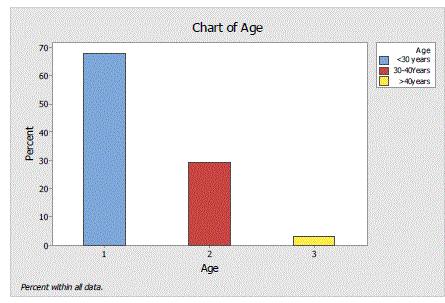 |
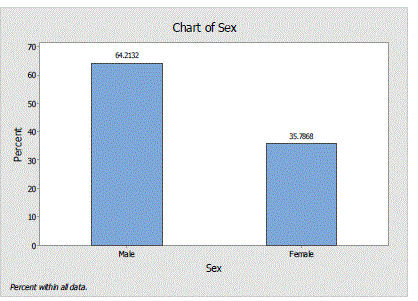 |
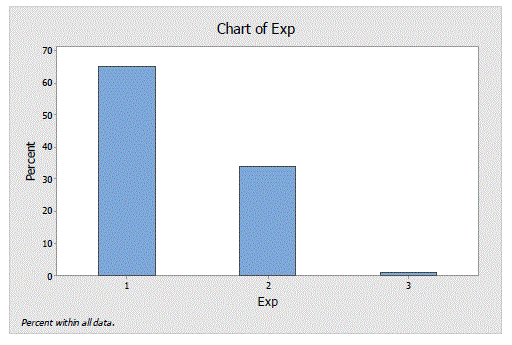 |
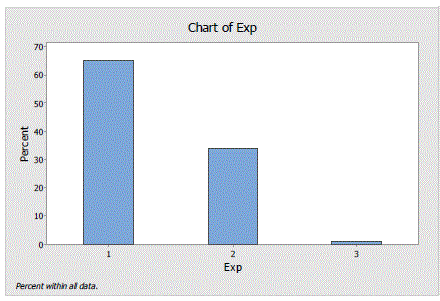 |
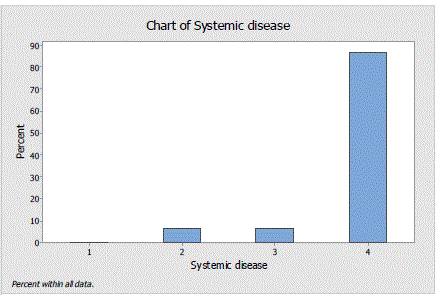 |
| Figure 1 |
Figure 2 |
Figure 3 |
Figure 4 |
Figure 5 |
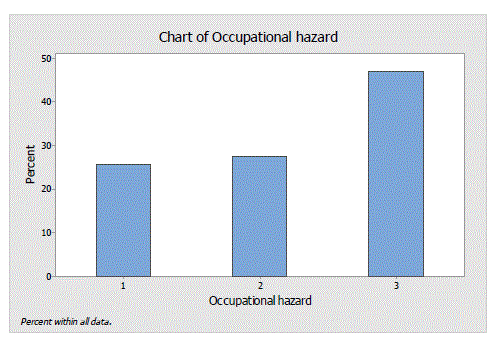 |
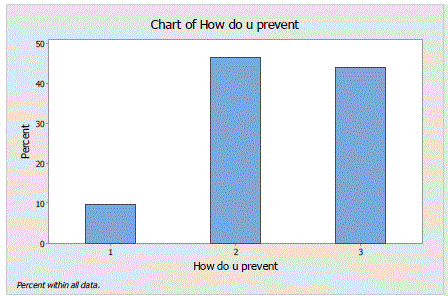 |
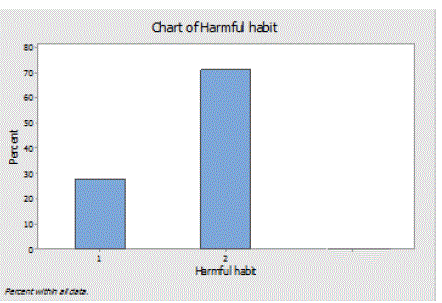 |
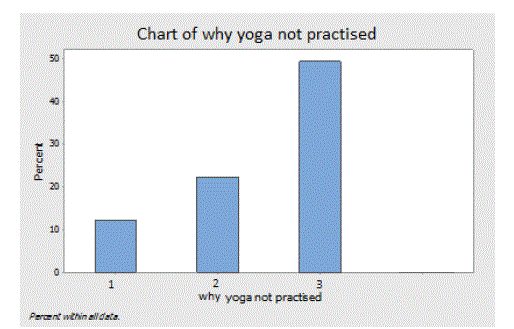 |
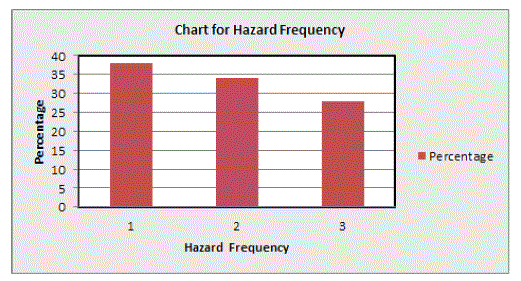 |
| Figure 6 |
Figure 7 |
Figure 8 |
Figure 9 |
Figure 10 |
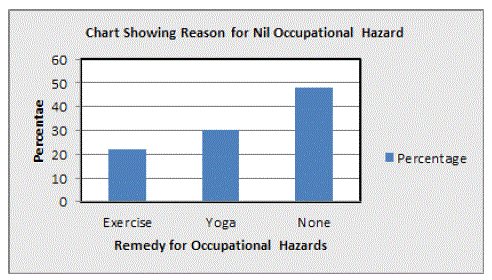 |
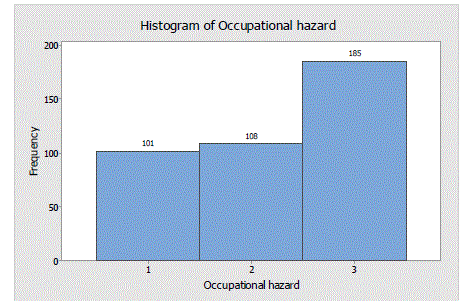 |
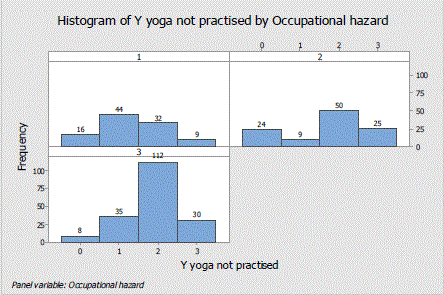 |
| Figure 11 |
Figure 12 |
Figure 13 |
|
| |
References
|
- Adebola FA, Owotade FJ.’ Occupational hazards among clinical dental staff.’ J Contemp Dent Pract 2004; 5: 134-52.
- Hagberg M, Wegman DH.’ Prevalence rates and odds ratios of shoulder-neck diseases in different occupational groups’. Br J Ind Med 1987; 44: 602-10
- Babar-Craig H, Banfield G, Knight J. ‘Prevalence of back and neck pain amongst ENT consultants: national survey’. J LaryngolOtol2003; 117: 979-82
- Alison M. Diaz, Morey J. Kolber, Chetan K. Patel, Patrick S. Pabian, Carey E. Rothschild, William J. Hanney, ‘The Efficacy of Yoga as an Intervention for Chronic Low Back Pain – A Systematic Review of Randomized Controlled Trials’, Am J LifestylMed. 2013;7(6):418- 430.
- Brooks SL, Rowe NH, Drach JC, Shipman C Jr, Young SK. ‘Prevalence of herpes simplex virus disease in a professional population’. J Am Dent Assoc 1981, 102: 31-4.
- Dr. FigenEres, Dr. TatjanaAtanasoska, ‘Occupational Stress of Teachers: A Comparative Study Between Turkey and Macedonia’, International Journal of Humanities and Social Science Vol. 1 No. 7[Special Issue –June 2011]
- Deyo RA, Weinstein JN. Low back pain.NEngl J Med. 2001;344:363–370.
- Andersson GB. Epidemiological features of chronic low-back pain. Lancet. 1999;354:581–585.
- Diamond S, Borenstein D. Chronic low back pain in a working-age adult. BestPract Res ClinRheumatol. 2006;20:707–720.
- Williams KA, Petronis J, Smith D, et al. Effect of Iyengar yoga therapy for chronic low back pain. Pain. 2005;115:107–117.
- Evans DD, Carter M, Panico R, Kimble L, Morlock JT, Spears MJ. Characteristics and predictors of short-term outcomes in individuals self-selecting yoga or physical therapy for treatment of chronic low back pain.PM R. 2010;2:1006–1015.
- Sherman KJ, Cherkin DC, Erro J, Miglioretti DL, Deyo RA. Comparing yoga, exercise, and a self-care book for chronic low back pain: a randomized, controlled trial.Ann Intern Med. 2005;143:849–856.
- Teets RY, Dahmer S, Scott E. Integrative medicine approach to chronic pain. PrimCare. 2010;37:407–421.
- Tekur P, Chametcha S, Hongasandra RN, Raghuram N. Effect of yoga on quality of life of CLBP patients: a randomized control study. IntJ Yoga. 2010;3:10–17.
- Hoy D, Brooks P, Blyth F, Buchbinder R. The epidemiology of low back pain. Best Pract Res ClinRheumatol. 2010;24:769–781.
- Van Tulder M, Koes B, Bombardier C. Low back pain. Best Pract Res ClinRheumatol. 2002;16:761–775.
- Saper RB, Eisenberg DM, Davis RB, Culpepper L, Phillips RS. Prevalence and patterns of adult yoga use in the United States: results of a national survey. AlternTher Health Med. 2004;10:44–49.
- Wolsko PM, Eisenberg DM, Davis RB, Kessler R, Phillips RS. Patterns and perceptions of care for treatment of back and neck pain: results of a national survey. Spine (Phila Pa 1976). 2003;28:292–297.
- R. Ramadoss, B.K. Bose, ‘Transformative Life Skills: Pilot Studies of a Yoga Model for Reducing Perceived Stress and Improving Self- Control in Vulnerable Youth’,International Journal of Yoga Therapy – No. 20 (2010)
- David C. Munz, Jennifer M. Kohler, and Carl I. Greenberg, ‘Effectiveness of a Comprehensive Worksite Stress Management Program: Combining Organizational and Individual Interventions’, International Journal of Stress Management, Vol. 8, No. 1, 2001
- AubreéChismark, Gary Asher, Margot Stein, Tabitha Tavoc, Alice Curran, ‘Use of Complementary and Alternative Medicine for Work–Related Pain Correlates With Career Satisfaction Among Dental Hygienists’, The Journal of Dental Hygiene, Vol. 85,No.4, 2011
- Revati C. Deshpande, ‘A healthy way to handle work place stress through Yoga, Meditation and Soothing Humor’, International Journal of Environmental Sciences Volume 2, No 4, 2012, ISSN 0976 – 4402
- Campbell, Debra Elise, and Kathleen A. Moore., (2004), Yoga as a preventative and treatment for depression, anxiety, and stress. International Journal of Yoga Therapy, 14, pp 53-58
|